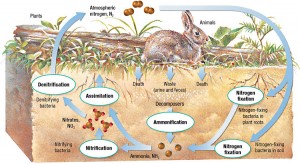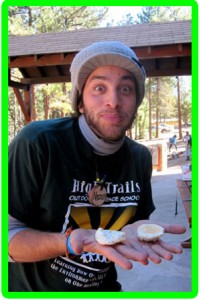 Did you know that there is an organism on this planet, which covers 3.4 square miles, and has been growing for over 2,000 years! It spreads mostly underground, growing unchecked in the Malheur National Forest in the Blue Mountains of eastern Oregon. Scientists did not fully understand its greatness until they began to investigate why so many trees in the area were dying off. When foresters cut into an infected tree they would find spreading white filaments, mycelia, which draw water and carbohydrates from the tree to feed the fungus. Researchers collected samples of the fungus from a widespread area and analyzed the DNA. A large sample of the specimens they collected turned out to be from a single organism. No, it is not a worm, or a giant tree of some sort, it is the Honey Fungus! It is a parasitic fungus that thrives in the drier climate of Eastern Oregon, as well as other places in the United States. Not only is it giant, but it is also edible! Russians, Poles and Ukrainians loved these things, and there is a traditional pierogi made in Ukraine with honey mushrooms.
Did you know that there is an organism on this planet, which covers 3.4 square miles, and has been growing for over 2,000 years! It spreads mostly underground, growing unchecked in the Malheur National Forest in the Blue Mountains of eastern Oregon. Scientists did not fully understand its greatness until they began to investigate why so many trees in the area were dying off. When foresters cut into an infected tree they would find spreading white filaments, mycelia, which draw water and carbohydrates from the tree to feed the fungus. Researchers collected samples of the fungus from a widespread area and analyzed the DNA. A large sample of the specimens they collected turned out to be from a single organism. No, it is not a worm, or a giant tree of some sort, it is the Honey Fungus! It is a parasitic fungus that thrives in the drier climate of Eastern Oregon, as well as other places in the United States. Not only is it giant, but it is also edible! Russians, Poles and Ukrainians loved these things, and there is a traditional pierogi made in Ukraine with honey mushrooms.
 This is one of the fun facts I have used to begin my Little World class here at High Trails. In this class we shed some light and appreciation on these creepy, crawly and sometimes disgusting organisms that play such a vital role in every ecosystem. FBI’S (fungus, bacteria, insects and scavengers) as we learn in class, are all decomposers. Decomposers breakdown dead material (called decomposition), which cleans our world of the natural and man-made garbage we produce every day. Without them, paper grocery bags would take a long time to decompose. However, within a healthy, decomposer friendly ecosystem, these paper bags can decompose in less than five months. Imagine life without decomposers; dead plant litter, animal carcasses and old tree trunks would cover our earth and forests! Gross! They are an essential and all encompassing part of the food chain. Surprisingly enough, this clean-up job is only one facet of what decomposers do.
This is one of the fun facts I have used to begin my Little World class here at High Trails. In this class we shed some light and appreciation on these creepy, crawly and sometimes disgusting organisms that play such a vital role in every ecosystem. FBI’S (fungus, bacteria, insects and scavengers) as we learn in class, are all decomposers. Decomposers breakdown dead material (called decomposition), which cleans our world of the natural and man-made garbage we produce every day. Without them, paper grocery bags would take a long time to decompose. However, within a healthy, decomposer friendly ecosystem, these paper bags can decompose in less than five months. Imagine life without decomposers; dead plant litter, animal carcasses and old tree trunks would cover our earth and forests! Gross! They are an essential and all encompassing part of the food chain. Surprisingly enough, this clean-up job is only one facet of what decomposers do.
The most important job that these creatures (F.B.I.S.) do is to cycle nutrients throughout an ecosystem.
 Plants use nutrients from the soil to grow. A rabbit can then come along and eat that plant to grow. Eventually the rabbit will die, either by being eaten by a predator or of natural causes. A dead animal (in this case a rabbit) is first broken down by scavengers. In our National Forest, this would most likely be a coyote or a vulture. These first scavengers may come across our poor dead rabbit and do the majority of the clean-up. Aside from some bones and fur, not too much will be left. Scavengers are part of the food webs in ecosystems. Scavengers provide a very important ecological service, because they help to rapidly reduce dead animals and plants to simpler constituents, and thereby prevent an excessive accumulation of dead biomass. Large quantities of dead animal biomass can represent an indirect health hazard to living animals, by enhancing the survival of disease.
Plants use nutrients from the soil to grow. A rabbit can then come along and eat that plant to grow. Eventually the rabbit will die, either by being eaten by a predator or of natural causes. A dead animal (in this case a rabbit) is first broken down by scavengers. In our National Forest, this would most likely be a coyote or a vulture. These first scavengers may come across our poor dead rabbit and do the majority of the clean-up. Aside from some bones and fur, not too much will be left. Scavengers are part of the food webs in ecosystems. Scavengers provide a very important ecological service, because they help to rapidly reduce dead animals and plants to simpler constituents, and thereby prevent an excessive accumulation of dead biomass. Large quantities of dead animal biomass can represent an indirect health hazard to living animals, by enhancing the survival of disease.
Next, fungi, bacteria and insects will finish up the job of decomposing our rabbit. In doing this, insects decompose the little bits that scavengers leave behind. In order to be used by plants, the “unusable” nitrogen must become what biologists called “fixed.” Fixation is the natural process where “unusable” gaseous nitrogen (N2) in the atmosphere and soil is converted or changed into the usable form of nitrogen, ammonia (NH3). This process is done by free-living bacteria in the soil, as well as bacteria that live on legume roots in a symbiotic relationship. While metabolizing these “unusab le” bacteria as food, they convert the nitrogen into an abundance of “usable” ammonia, which can then be consumed by plants! This begins the cycle again, wherein plants can use the nitrogen to grow big and strong so another bunny can be sustained by it. Pretty darn cool!
le” bacteria as food, they convert the nitrogen into an abundance of “usable” ammonia, which can then be consumed by plants! This begins the cycle again, wherein plants can use the nitrogen to grow big and strong so another bunny can be sustained by it. Pretty darn cool!
Playing the role of nutrient recycler and garbage man, decomposers really have a very important but often overlooked role in our ecosystem. Think twice before you find yourself being utterly grossed out by these creepy, crawly and seemingly unimportant organisms, for they play a bigger role than you may realize! Embrace those little critters! A big warm compost bin is a great way to see the work of decomposers first-hand. Anyone who has seen a pile of leafy greens and hay turn into a giant pile of lush black soil can attest to the awesome power that are: DECOMPOSERS!
 At High Trails Outdoor Science School, we literally force our instructors to write about elementary outdoor education, teaching outside, learning outside, our dirty classroom (the forest…gosh), environmental science, outdoor science, and all other tree hugging student and kid loving things that keep us engaged, passionate, driven, loving our job, digging our life, and spreading the word to anyone whose attention we can hold for long enough to actually make it through reading this entire sentence. Whew…. www.dirtyclassroom.com
At High Trails Outdoor Science School, we literally force our instructors to write about elementary outdoor education, teaching outside, learning outside, our dirty classroom (the forest…gosh), environmental science, outdoor science, and all other tree hugging student and kid loving things that keep us engaged, passionate, driven, loving our job, digging our life, and spreading the word to anyone whose attention we can hold for long enough to actually make it through reading this entire sentence. Whew…. www.dirtyclassroom.com

Comments are closed.